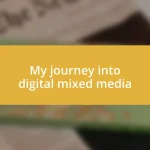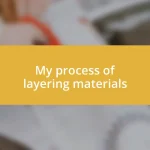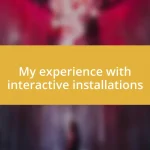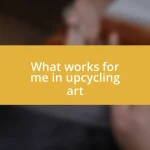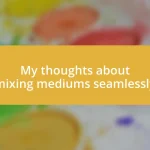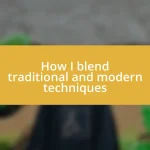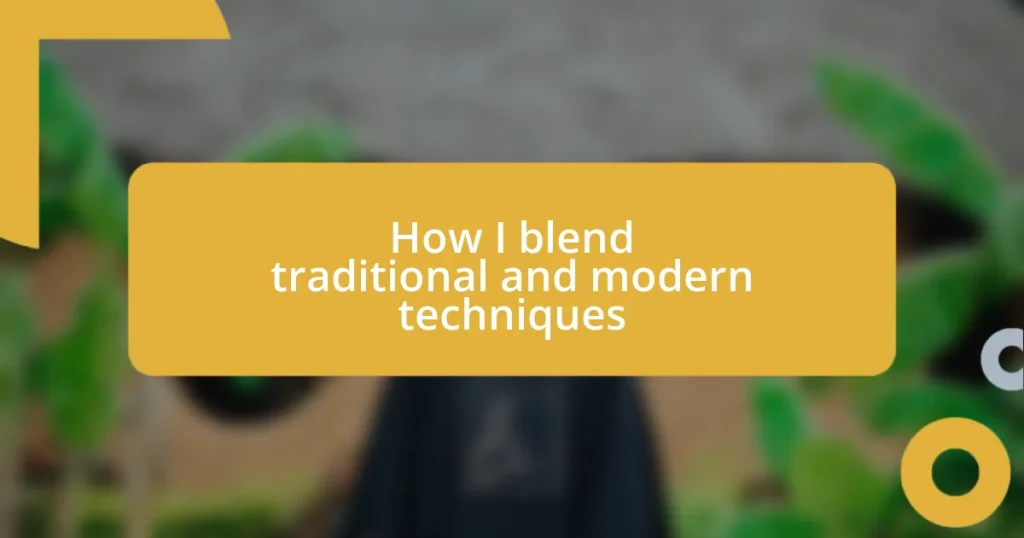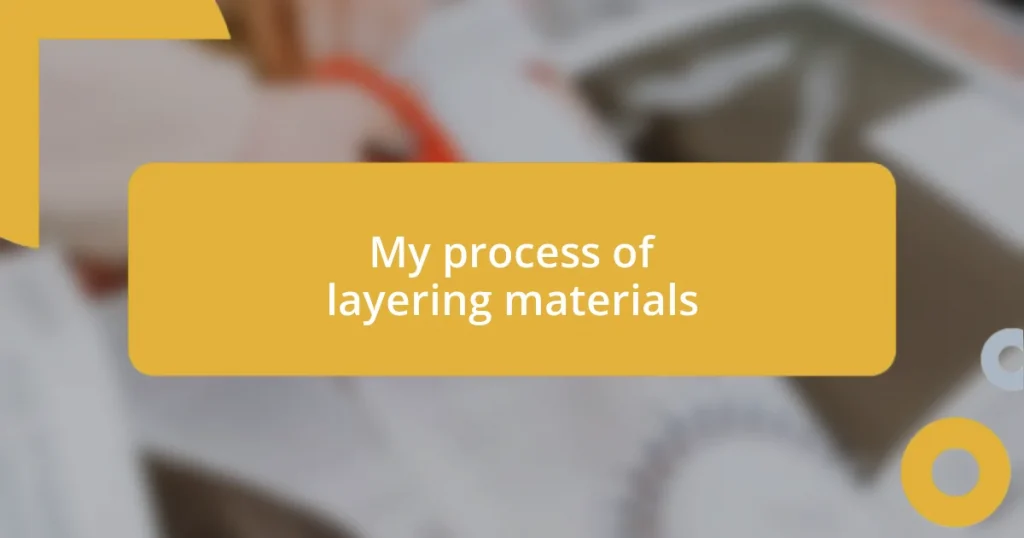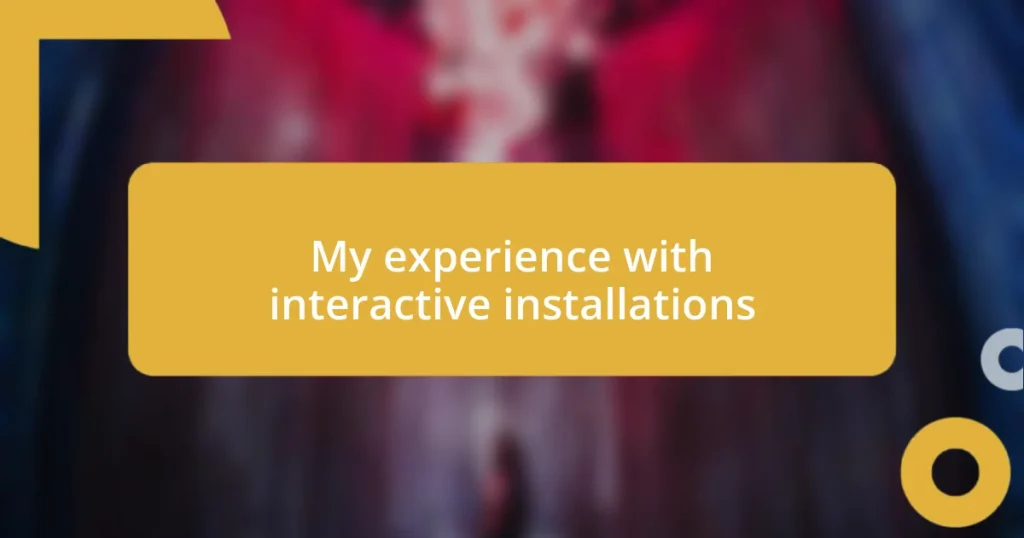Key takeaways:
- Blending traditional and modern techniques enhances creativity and fosters a deeper connection to art and culture.
- Practical applications of this blend can elevate everyday life, from home decor to cooking and gardening.
- Continuous experimentation, seeking feedback, and ongoing learning are essential for refining the integration of these diverse techniques.

Understanding traditional techniques
Traditional techniques hold a wealth of knowledge that often feels like a bridge to our past. I remember the first time I tried my hand at an age-old craft— the process was slow, but the connection I felt to history was profound. Have you ever put your mind to something that has been done for generations and felt that rush of belonging?
These methods, passed down through generations, often come with their own set of rituals and stories. Each technique has a rhythm, a heartbeat that reflects the culture it originates from. I often find myself thinking about the patience required in traditional practices, like weaving or pottery. It’s almost meditative; don’t you feel that way when immersed in a craft?
When we consider traditional techniques, it’s essential to appreciate their role in preserving identity and culture. In my experience, mastering these skills often opens a door to understanding the values and principles behind them. Have you ever felt a sense of pride in recreating something that’s been cherished for centuries? It’s an experience that binds us to our roots in ways we might not initially understand.

Exploring modern techniques
Modern techniques bring a fresh perspective, often infused with technology and innovation. I vividly remember experimenting with a digital design program for a project, where I was amazed at how effortlessly I could manipulate colors and shapes compared to traditional methods. This blend of creativity and technology sparked a new enthusiasm in me; isn’t it exhilarating how we can push boundaries using tools that were unimaginable just a few years ago?
Some key aspects of modern techniques include:
- Digital Fabrication: Technologies like 3D printing that allow for precise, intricate designs that may be impossible to achieve by hand.
- Augmented Reality (AR): This offers an immersive experience, letting creators visualize and interact with their work in real-time.
- Sustainable Materials: Innovations in materials science have led to eco-friendly options that do not sacrifice quality for environmental consciousness.
- Social Media Outreach: Platforms allow artisans to showcase their work globally, connecting them with a wider audience and fostering collaboration.
These elements not only enhance the creative process but also democratize art, making it accessible and engaging for everyone.

Identifying complementary elements
Determining which elements complement each other when blending traditional and modern techniques can be truly enlightening. In my journey, I’ve noticed how the tactile quality of hand-made crafts pairs beautifully with digital elements. While working on a project that incorporated both hand-painted illustrations and digital layering, the final outcome felt richer and more textured than if I had relied on just one method. Have you ever tried combining different styles and discovered that they enhance each other?
It’s fascinating to observe how certain aspects of tradition can introduce depth to modern practices. Take, for instance, incorporating traditional color palettes into contemporary graphic designs. I once tackled a community mural project that used ancient motifs, which surprisingly brought a sense of familiarity to passersby, making the artwork feel more inviting. It’s incredible how such an approach can foster a deeper connection with the audience—how about that feeling when people stop to admire and discuss the details in your work?
When I reflect on my experience with blending different techniques, I often come back to the role of storytelling. Each element we choose to mix tells its own story—this could be the history behind a traditional pattern or the innovation of modern tools. I remember attending a workshop that challenged us to create a piece that showcased both perspectives. The resulting artwork not only sparked conversation but also bridged cultural gaps, engaging those with different backgrounds. Isn’t it amazing to see how our creative choices can connect people in unexpected ways?
| Traditional Techniques | Modern Techniques |
|---|---|
| Hands-on craftsmanship | Digital precision |
| Rich history and culture | Innovation and technology |
| Emphasis on rituals and storytelling | Use of social media for collaboration |

Creating a hybrid approach
Creating a hybrid approach involves thoughtful consideration of how to merge the strengths of both traditional and modern techniques. I remember a project where I used aged wood and fine metalwork alongside advanced laser engraving. The contrast not only brought an old-world charm to the piece but also highlighted the precision of modern technology. Isn’t it interesting how juxtaposing these elements can create a truly unique narrative?
I find that the emotional resonance of traditional methods adds depth that modern techniques alone often lack. For example, during a ceramics workshop, I witnessed how my handmade bowls could be simultaneously fired in a traditional kiln and adorned with digital prints. The bowls told a story of heritage while embracing contemporary aesthetics, creating a hybrid identity that was both timeless and innovative. How often do we encounter pieces that invite us to contemplate the fusion of past and future?
It’s essential to remain open and adaptable when crafting this hybrid approach. I often experiment by allowing mistakes from traditional crafting to inform my modern designs, leading to unexpected outcomes that inspire new ideas. During one of my explorations, a smudge in my watercolor technique gave rise to a digital effect that I would’ve never envisioned otherwise. Isn’t it fascinating how the creative process can unveil possibilities we never anticipated?

Practical applications in daily life
Practical applications of blending traditional and modern techniques often manifest in everyday life in remarkable ways. I recall a time when I incorporated traditional weaving techniques into my home decor. Using handmade textiles with contemporary design elements transformed my living space, creating a cozy yet modern atmosphere. Have you ever noticed how a simple blend of old and new can instantly elevate the aesthetic of your environment?
In the kitchen, merging traditional recipes with modern cooking methods can lead to delicious discoveries. I experimented with using my grandmother’s age-old pasta recipe but employed a modern pasta maker. The results were stunning—perfectly shaped noodles with the cherished flavor of family tradition. Isn’t it rewarding to see how evolving our processes can create delightful new experiences?
I’ve also found that applying traditional gardening methods alongside modern technology can yield extraordinary results. For example, I combined a classic permaculture technique, like companion planting, with smart watering systems. This not only enhanced the garden’s health but also made it easier to manage. Have you ever thought about how blending these approaches can simplify our daily tasks while keeping the charm of tradition alive? It’s fascinating to see how these simple adjustments can bring both efficiency and joy to our lives.

Case studies of successful blends
One of my favorite examples of successfully blending traditional and modern techniques comes from a fashion design project I undertook. Utilizing hand-stitched embroidery, I paired it with high-tech fabric that incorporates moisture-wicking properties. The garments not only looked stunning but also performed beautifully in sweat-inducing situations. Isn’t it rewarding to see how old-world craftsmanship can elevate modern functionality?
Another success story I cherish involved a community art installation. We combined local artisans’ traditional pottery techniques with augmented reality (AR). Viewers could scan the pieces with their phones, revealing tales of the artisans and their craft through animated graphics. That fusion didn’t just showcase the artistry; it created an interactive experience that connected the past to the present. How often do we encounter art that engages us in such an immersive way?
Lastly, I want to share an intriguing culinary journey. While exploring fusion cuisine, I preserved my family’s traditional curry recipe but concocted it in a sous-vide setup. The results were astonishing—a depth of flavor I’d never achieved through conventional cooking. This interplay between the time-honored method and modern precision opened a new culinary avenue for me. Have you ever tried merging your family’s recipes with today’s cooking technology? The possibilities are endless and deeply satisfying!

Tips for ongoing refinement
An effective way to refine your blending of traditional and modern techniques is to keep experimenting. I remember when I first attempted to mix traditional painting styles with digital art software. Initially, the results were uneven, but with each attempt, I learned more about what worked and what didn’t. How often do we shy away from experimentation because we fear failure? Embracing those early missteps became a vital part of my process, paving the way for unique creations I never could have imagined.
Another tip I find invaluable is to gather feedback from diverse perspectives. I once shared a project that combined traditional calligraphy with contemporary graphic design with a group of friends. Their varied insights highlighted aspects I hadn’t considered, enhancing the final piece immensely. Have you thought about how valuable external input can be? Engaging with others not only nurtures innovation but also creates a sense of community around your work.
Lastly, continual learning is crucial. I’ve signed up for workshops that focus on both ancestral crafts and cutting-edge technology. One session on laser cutting techniques opened my eyes to how I could amplify traditional designs. Isn’t it thrilling to witness how new knowledge can consciously shape our artistic choices? Each new skill I acquire has not only refined my approach but also infused a fresh energy into my previous techniques, breathing new life into my creative journey.
